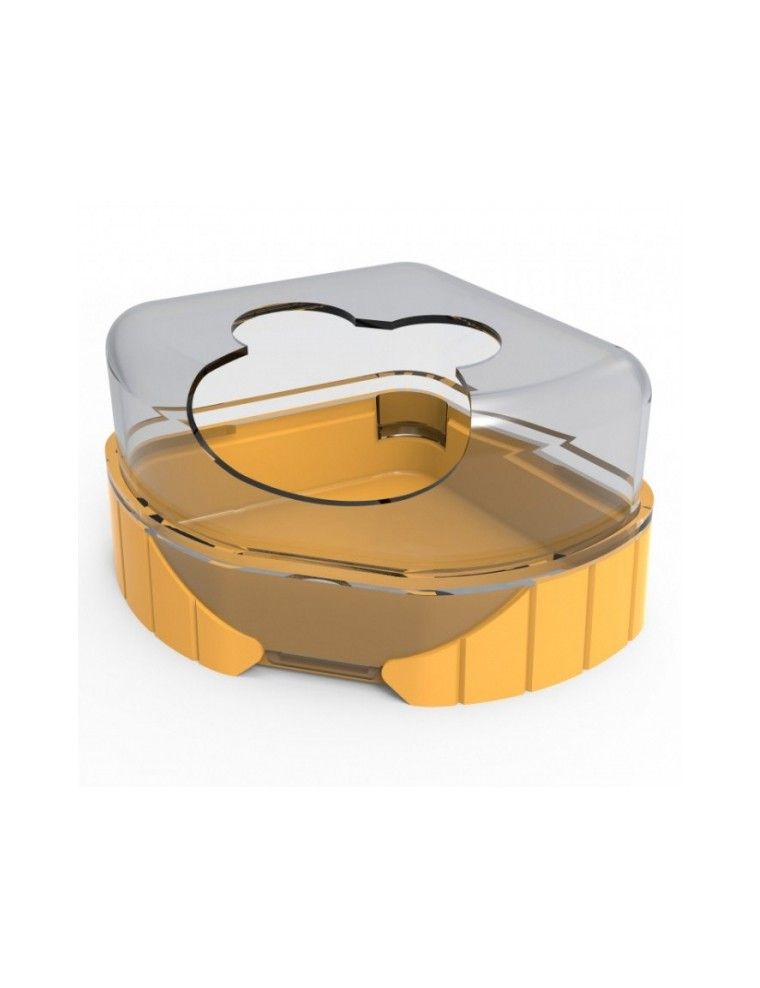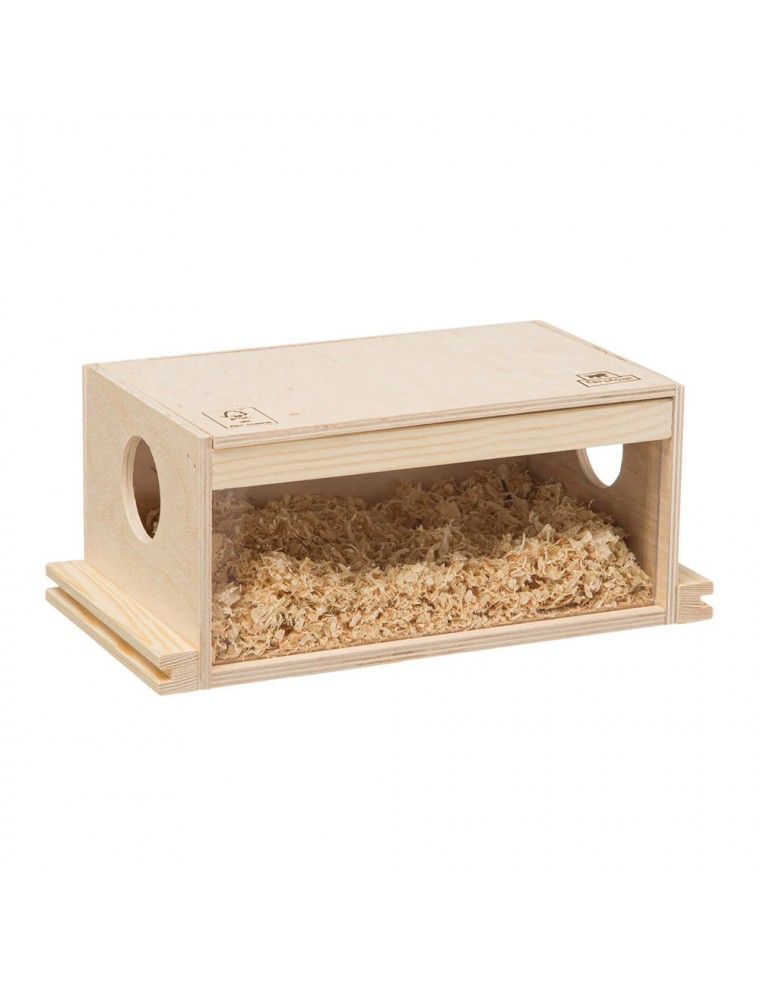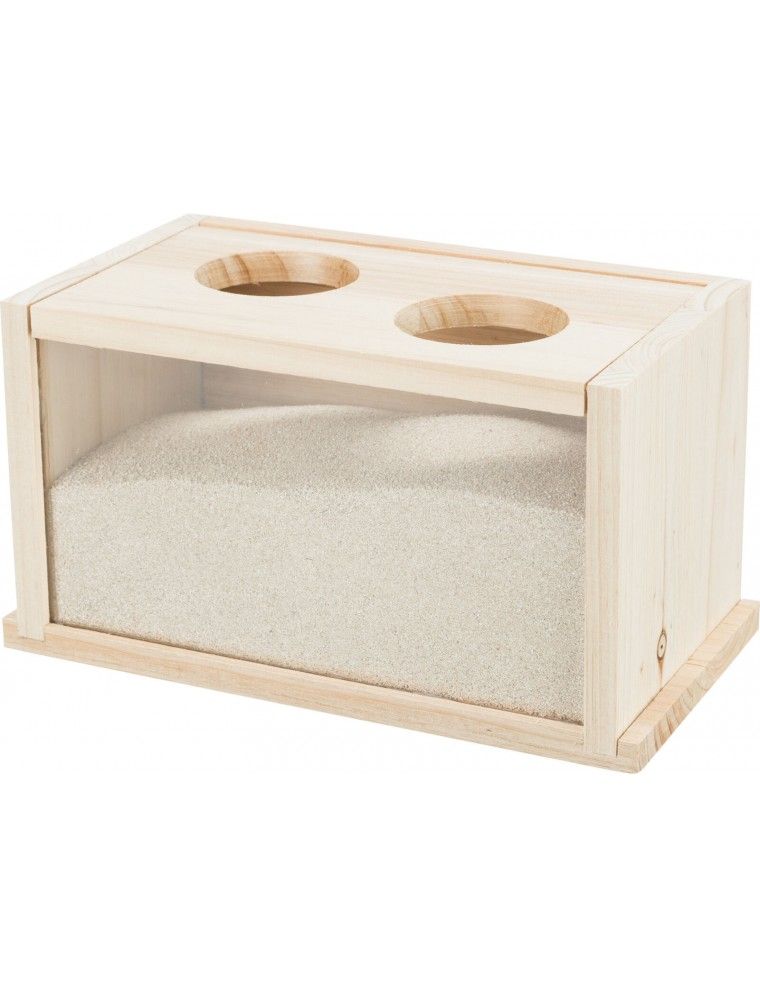- in replenishment
Sandbox Hamster
The Hamster Sandbox: Essential for a Healthy Coat
At Le Petit Rongeur, the well-being of your little friends is our priority. This is why we provide you with an exclusive selection of sandboxes for hamsters, an essential accessory for maintaining their coat. Available in wood and plastic, our sandboxes offer a natural and pleasant solution so that your hamster can clean, degrease and cool off, while having fun. With recognized brands such as Ferplast , Trixie , and Zolux , choose the box that will fit perfectly into your hamster's habitat.
A Sand Bath, Why Is It Essential?
Hamsters, especially species from desert areas like the Syrian hamster or the Roborovski, have an instinctive need to bathe in sand to keep their coat healthy. Sand acts as a natural degreasing agent, removing excess oil and preventing skin problems. In addition, on hot summer days, the sand offers welcome coolness to your little companion. At Le Petit Rongeur, we recommend the use of specific sand, such as chinchilla sand, adapted to the delicate skin of hamsters and designed to meet their grooming needs.
The Benefits of a Regular Sand Bath
Regular sand bathing is essential for your hamster's comfort and health. It helps keep the coat clean, free of grease and parasites, while providing an entertaining activity that stimulates their natural grooming behavior. The wooden or plastic sandboxes in our selection are designed to fit seamlessly into your hamster's cage, providing a safe and attractive space for those moments of self-care. A sand bath is not just a way to maintain hygiene; it is also a preventive practice against itching and skin diseases.
Choosing the Ideal Sandbox for Your Hamster
Selecting a suitable sandbox depends on several factors, including the size of the cage, the type of hamster, and your personal preferences for materials and design. Our wooden sandboxes offer a natural and eco-friendly look, while plastic ones are easy to clean and move. Whatever your choice, Le Petit Rongeur is committed to providing you with quality products that are safe for your pet and designed to last.
At Le Petit Rongeur, our goal is to help you provide your hamster with an enriching and healthy habitat. Discover our range of sandboxes and provide your little companion with natural and playful grooming, thus contributing to their overall well-being.
Sandbox
The Hamster Sandbox: Essential for a Healthy Coat
At Le Petit Rongeur, the well-being of your little friends is our priority. This is why we provide you with an exclusive selection of sandboxes for hamsters, an essential accessory for maintaining their coat. Available in wood and plastic, our sandboxes offer a natural and pleasant solution so that your hamster can clean, degrease and cool off, while having fun. With recognized brands such as Ferplast , Trixie , and Zolux , choose the box that will fit perfectly into your hamster's habitat.
A Sand Bath, Why Is It Essential?
Hamsters, especially species from desert areas like the Syrian hamster or the Roborovski, have an instinctive need to bathe in sand to keep their coat healthy. Sand acts as a natural degreasing agent, removing excess oil and preventing skin problems. In addition, on hot summer days, the sand offers welcome coolness to your little companion. At Le Petit Rongeur, we recommend the use of specific sand, such as chinchilla sand, adapted to the delicate skin of hamsters and designed to meet their grooming needs.
The Benefits of a Regular Sand Bath
Regular sand bathing is essential for your hamster's comfort and health. It helps keep the coat clean, free of grease and parasites, while providing an entertaining activity that stimulates their natural grooming behavior. The wooden or plastic sandboxes in our selection are designed to fit seamlessly into your hamster's cage, providing a safe and attractive space for those moments of self-care. A sand bath is not just a way to maintain hygiene; it is also a preventive practice against itching and skin diseases.
Choosing the Ideal Sandbox for Your Hamster
Selecting a suitable sandbox depends on several factors, including the size of the cage, the type of hamster, and your personal preferences for materials and design. Our wooden sandboxes offer a natural and eco-friendly look, while plastic ones are easy to clean and move. Whatever your choice, Le Petit Rongeur is committed to providing you with quality products that are safe for your pet and designed to last.
At Le Petit Rongeur, our goal is to help you provide your hamster with an enriching and healthy habitat. Discover our range of sandboxes and provide your little companion with natural and playful grooming, thus contributing to their overall well-being.
- in replenishment
- 3 in stock
Questions / Réponses
Un bac à sable offre aux hamsters une méthode naturelle pour nettoyer leur fourrure en se roulant dans le sable, ce qui aide à éliminer l'excès d'huile et à garder leur pelage propre et sain. Cela imite leur comportement dans la nature.
Utilisez du sable fin spécialement conçu pour les hamsters ou les chinchillas, sans poussière et non parfumé, pour éviter les irritations respiratoires. Évitez le sable à gros grains, car il peut être abrasif pour leur peau.
Placez le bac à sable dans un coin de la cage, loin de la zone de nourriture et de l'eau pour éviter la contamination. Les hamsters choisiront souvent un coin de leur cage pour se soulager, donc le placement peut encourager cette habitude.
Cela dépend de l'utilisation, mais en général, il est bon de tamiser le sable tous les jours pour enlever les déchets et le changer complètement une fois par semaine pour maintenir une hygiène appropriée.
Il est normal que les hamsters goûtent au sable par curiosité, mais ils ne devraient pas en manger en grande quantité. Assurez-vous que le sable est non toxique et spécifiquement conçu pour l'usage animal.
La plupart des hamsters apprécient de se rouler dans le sable, mais certains peuvent être réticents ou indifférents. Introduisez-le doucement et observez si votre hamster montre de l'intérêt.
Non, ces types de sable ne sont pas recommandés car ils peuvent contenir des impuretés, des bactéries ou être trop abrasifs pour la peau délicate d'un hamster. Utilisez toujours du sable spécifique pour petits animaux.
Oui, le sable peut aider à absorber certaines odeurs, mais il ne remplace pas un nettoyage régulier de la cage et un entretien approprié. Un bac à sable propre contribue à une cage plus hygiénique.
Les hamsters sont des animaux propres par nature et devraient naturellement être attirés par le sable pour se nettoyer. Placez votre hamster dans le bac à sable et laissez-le explorer. Avec le temps, il devrait commencer à l'utiliser instinctivement pour se baigner.
Bien qu'un bac à sable soit un excellent outil pour aider à maintenir le pelage de votre hamster propre, il ne remplace pas le besoin d'une cage propre, d'une alimentation saine et d'un environnement enrichissant pour le bien-être général de votre hamster.


